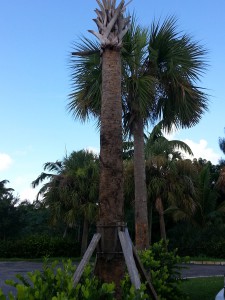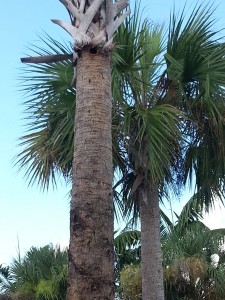There is Life in a Dead Tree
Dead and dying trees, often thought of as dangerous or unsightly, are usually removed. When a tree poses little threat to human safety, allowing it to remain in place provides habitat. The National Wildlife Federation defines a dead tree that is left in place to decompose naturally as a snag.
The sabal palm tree pictured at right is in the parking lot at town hall. The tree became stressed and did not survive transplant, dying slowly over a period of about a year. As part of regular maintenance, it was slated for removal.
Staff noticed active use of the tree by both an eastern gray squirrel as well as repeated use by an unconfirmed species of woodpecker. While a public parking lot is not an ideal spot for a snag, the dead palm provides an opportunity for the Town to highlight the usefulness of snags and to bring awareness to another thing that makes our wonderful community so unique. Many wildlife species depend on dead trees, without which they would disappear. With more land on our properties than in surrounding areas, Ranchers may be able to safely allow dead trees to remain for the use of wildlife species that depend on decaying wood. When a tree dies in a relatively safe area, possibly the most beneficial action is to take no action at all.


The Town’s arborist will monitor this snag on a daily basis, allowing it to remain in place while active use by wildlife is observable. Tree stakes, which would ordinarily have been removed within the first year of the tree being transplanted, will also be left in place to reduce risk of the tree falling.
For more information about what you can do to enhance habitat for wildlife, visit:
Garden for Wildlife
Attracting Wildlife with Dead Trees
U.S. Forestry Service Wildlife Trees
